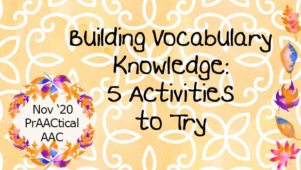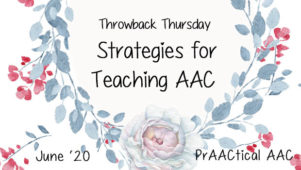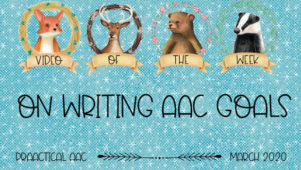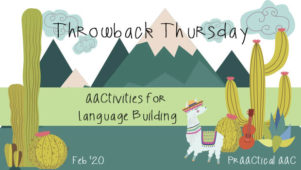Building Linguistic Competence in AAC Learners: 3 Areas to Consider Targeting
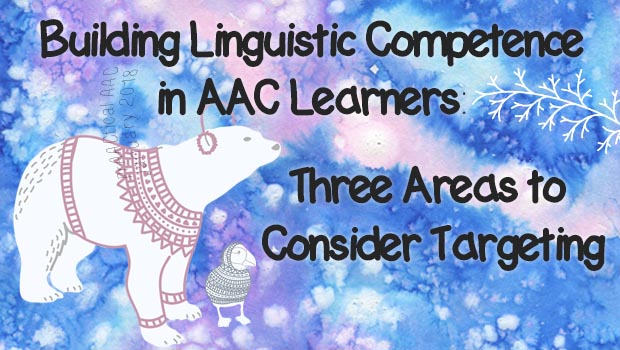
For several years, those who specialize in supporting AAC learners have stressed the need to develop AAC systems and programming that go beyond the communicative function of requesting in order to target the ability to protest, reject, comment, etc. This has been an important trend that will empower users of AAC to express themselves in much fuller ways.
What other things should we be targeting in order to help our clients and students become more linguistically competent? Here are some ideas for goal areas to consider.
- Temporal Markers: While no one can overstate the importance of talking about our current needs, interests, observations, and preferences, we have to be careful not to get stuck in the moment. It is also important for our AAC learners to develop the language skills to be able to talk about things that already happened or that will/might be happening.
- Why? Among other things, this skill area is an important part of academic achievement. The books we read, the things we write, the tests we take, all make heavy use of the past and future tense. More importantly, we use language to process our experiences. When a student is upset, he/she will need to go beyond labeling his/her emotions. They need the language and language skills to discuss their experience (i.e., what is making them feel that way) and figure out what to do about their emotional state. Sometimes talking about it is enough. (Who among us doesn’t vent to a trusted friend occasionally?) At other times, we need this language to plan out a resolution (e.g., getting help, going somewhere, doing something). Temporal markers are also important for clarity and helping others understand our true intent. When Brayden says ‘sad’ it may not mean that he is feeling that way right now. He could be telling us about seeing the movie Coco last weekend or empathizing with a classmate who was crying yesterday. If we teach him a way to anchor his message in time, that helps us better understand his true intent.
- Beginning communicators may do this with words or phrases that give us a time context for their message. With instruction and lots of modeling, they can learn to tell us whether their message relates to something that is happening now, already happened, or hasn’t happened yet. PODD does this beautifully, and it is a lesson we can export to communicators who use other forms of AAC as well.
- More advanced language users may develop this skill by becoming more proficient in verb tenses (e.g., I do, I did, I will do) and modal verbs (e.g., I would do, I might have done, I will be doing). These are exactly the kind of grammatical skills that often make the language of our AAC students/clients sound immature when compared to their age mates. Because we often prioritize speed and expediency over other things, we sometimes fail to teach and practice more sophisticated language skills. That’s a big problem for our clients/students who have the potential to develop these skills but don’t get there on their own. What we teach, they will learn.
- Personal Narratives: Since prehistoric times, humans have been telling stories in whatever manner they could. From vocalization and gestures to pictures, words, and print, it seems that we were born to share our experiences with others. Personal narratives, the stories we create about ourselves and the things we do, are typically the first type of narratives we share. Let’s not underestimate the value of teaching AAC learners to express themselves in this important way.
- Beginning Communicators: We can co-construct those stories with our most emergent communicators who need extensive supports and build their narrative skills over time. Yes, Johnny may only be at the single word level with his AAC system, but that doesn’t mean he can’t learn to tell about his trip to Disney or the disastrous pancake recipe they made in Life Skills class. With the support of a strong communication partner, goals in narrative language allow students like this to use their single word vocabulary to share what they’ve done and how they feel about it.
- Context-dependent Communicators: These communicators can assume more of the responsibility of putting together stories, but will still need quite a lot of instruction, experience, and support. They may benefit from learning an explicit structure (e.g., first, then, last) with visual supports to get the hang of story sequencing, but it is a wonderful vehicle for practicing multi-word utterances (e.g., I go Disney. It really cold. New sweatshirt.), among other things.
- Independent Communicators: Our independent communicators may be wonderful at navigating their AAC systems, but often, their language is less sophisticated than their same age peers. These students and clients may benefit from working on more advanced personal narratives to ensure that they can express themselves clearly and fully. Antoine, for example, was eager to share things that happened to him but often started his stories in the middle or included reference to characters or events that his communication partner knew nothing about. When Antoine told a story, his partners usually had to ask lots of questions to figure out exactly what happened. He needed help learning to take his partner’s point of view and be sure that he provided the right kind of information (e.g., WHO he’s talking about, WHERE it happened) in the right order. Kaitlyn had no difficulty with those things but didn’t provide enough descriptive information to make the story compelling. She learned to add interest to her personal narratives with Tier 2 vocabulary (e.g., huge or ginormous rather than big; insist or assert rather than tell) and transform her plain 5-word sentences into more complex sentences with the help of later-developing conjunctions (e.g., since, after, although).
- Asking Relevant Questions: It’s not uncommon for AAC learners to have goals for WH questions, but usually the target behavior relates to ANSWERING those questions. That’s important, of course, but we shouldn’t underestimate the need to teach them to ASK questions, too.
- Why? First, it changes how other people view the AAC communicator. A child who asks “Why?” or “Why do I have to?” is perceived differently from the one who doesn’t. For starters, we perceive them as wanting information and expecting an answer. We’ve written about the critical role of perception and expectation here and in other posts. Beyond that, it empowers the communicator to get information and learn about the world. It helps with vocabulary and language development, too, because it obliges their partners to respond. That’s important because we tend to speak LESS to people who use AAC than we do to people who use their natural speech. Typically developing toddlers and preschoolers drive us crazy with their incessant questioning just at the time when they are making enormous strides in language learning (remember those vocabulary bursts?!). They ask questions and get lots of language input-new words (e.g., “It’s freezing outside!”) and new grammatical structures (e.g., “You need to hold my hand because the sidewalk is so slippery”). We need to give that same control to our AAC learners. [More about that here.]
- Beginning communicators will need lots of structure and support for this, but these are skills they can learn. Prestored messages are helpful here, too (e.g., “What’s next?” “Where are we going?” “What is that?”). What we teach, they will learn.
- More advanced language users can also benefit from prestored messages that can be delivered quickly and efficiently in class discussions (e.g., “What do you mean by that?” “Doesn’t that relate to what I said?” “How am I supposed to do that?”) and social interactions (e.g., “Do you see what I mean?” “Can you slow down while I tell you something?” “How did it turn out?”). At other times, we may want them to be able to construct specific questions in the moment. Kaitlyn needs to be able to ask specific questions of her job coach (e.g., “What should I do if I can’t find Ellen when I’m done?” “Where do the towels go?”), teachers (e.g., “Why didn’t Brianna come to pre-Algebra today?” “Where do we meet our peer buddies?”), and friends (e.g., “Why didn’t you text me back yesterday?” “Do you want to meet at American Eagle or the food court?”). Just because they have better language skills than other users of AAC on our caseloads or in our classes, doesn’t mean they’ve reached their potential or will do so just by observing others. Assume that they will need direct instruction and targeted support to develop these important skills.
Bottom Line: Let’s keep raising the bar in terms of language instruction and move our AAC students and clients further along in the journey toward linguistic competence. Most of our AAC learners have the capacity to develop these language skills but they are probably not going to acquire them without specific intervention. That’s what presuming potential is all about. What we teach, they will learn.
Are there other language skills that are under-emphasized in AAC therapy and instruction? We’d love to hear about those.
Filed under: Featured Posts, PrAACtical Thinking
Tagged With: goal setting, goals, language development, language goals, language intervention
This post was written by Carole Zangari

